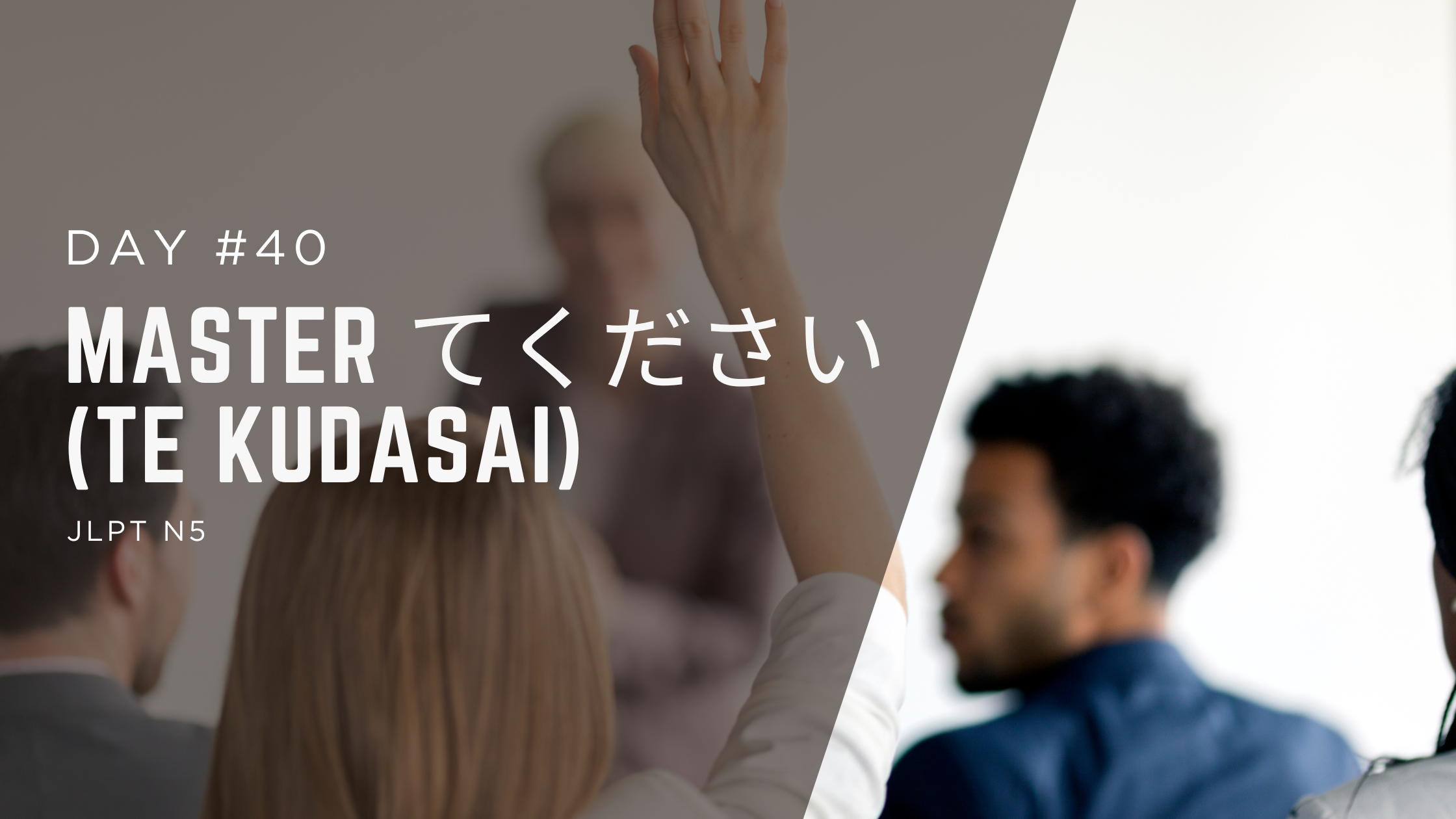Congratulations on reaching Day 40 of our 100-day JLPT N5 challenge!
Today, we’re tackling てください (te kudasai), a polite way to ask someone to do something—think “Please do this” or “Could you please…?”
Mastering てください is key for JLPT N5 prep, boosting your grammar skills and earning points on the exam. You’re 40% of the way to N5 success—keep pushing forward with learn Japanese for beginners enthusiasm!
Main Lesson: Understanding てください Step-by-Step
Let’s dive into てください (te kudasai), a polite request form that combines the te-form of a verb with ください (kudasai, “please”).
It’s simple yet powerful, perfect for adult learners. Pronounced “teh koo-dah-sigh” in romaji, it’s a soft, respectful way to ask for action.
Grammar Rules
- Structure: Take a verb, change it to its te-form (based on its group: u-verbs, ru-verbs, or irregular), then add ください.
- Verb Groups:
- U-verbs: Change the final vowel sound (e.g., よむ → よんで, のむ → のんで).
- Ru-verbs: Drop る and add で (e.g., たべる → たべて, ねる → ねて).
- Irregular: する → して (shite)
- Meaning: It’s a polite request, implying “Please do ~” or “Could you please ~?” Never use it for commands—it’s always courteous.
Vocabulary List
Here’s a beginner-friendly list to practice with, aligned with JLPT N5 prep:
| words | Romaji | English | +ください |
|---|---|---|---|
| かく | kaku | To write | かいて ください |
| よむ | yomu | To read | よんで ください |
| たべる | taberu | To eat | たべて ください |
| のむ | nomu | To drink | のんで ください |
| くる | kuru | To come | きて ください |
| いく | iku | To go | いって ください |
Examples
Let’s see てください in action with the vocabulary:
- ひらがな を かいて ください。 (Hiragana wo kaite kudasai.) – Please write Hiragana.
- Te-form of かく (kaku) + ください.
- カタカナ を よんで ください。 (Katakana wo yonde kudasai.) – Please read Katakana.
- Te-form of よむ (yomu) + ください.
- ごはん を たべて ください。 (Gohan wo tabete kudasai.) – Please eat rice.
- Te-form of たべる (taberu) + ください.
- みず も のんで ください。 (Mizu mo nonde kudasai.) – Please drink water too.
- Te-form of のむ (nomu) + ください.
- べんきょう して ください。 (Benkyou shite kudasai.) – Please study.
- Te-form of する (suru) + ください.
- いえ に きて ください。 (Ie ni kite kudasai.) – Please come to my house.
- Te-form of くる (kuru) + ください.
Cultural Notes
In Japan, politeness is key, especially for adults interacting in formal or semi-formal settings.
てください reflects the cultural value of respect.
In daily life, shop staff might say おまちください (Omatase kudasai – Please wait), blending てください with honorifics.
As learners, using this form correctly will earn you smiles and respect!
Practice Section: Multiple-Choice Quiz
Test your skills with this JLPT N5-style quiz. Choose the best answer for each of six questions.
Question 1: What does たべて ください (Tabete kudasai) mean?
Question 2: Which is the correct te-form for よむ (yomu)?
Question 3: Translate “Please come here” into Japanese.
Question 4: Which sentence is a polite request?
Question 5: Complete: すこし ____ ください。 (Sukoshi ____ kudasai.) – Please sleep a little.
Question 6: Complete: にほんご を ____ ください。 (Nihongo wo ____ kudasai.) – Please write Japanese.
Conclusion: Key Takeaways and Next Steps
Today, we conquered てください, the polite way to say “Please do ~” by combining te-forms with ください.
From たべてください (Please eat) to きてください (Please come), you’ve learned a versatile tool for learn Japanese for beginners.
With grammar rules, a vocab list, examples, and a quiz, you’re strengthening your N5 foundation. Consistency is your superpower—dedicate a few minutes daily to review.
Loved this lesson? Subscribe to our newsletter for daily JLPT N5 tips, or share with fellow learners.
Let’s keep mastering Japanese together!



